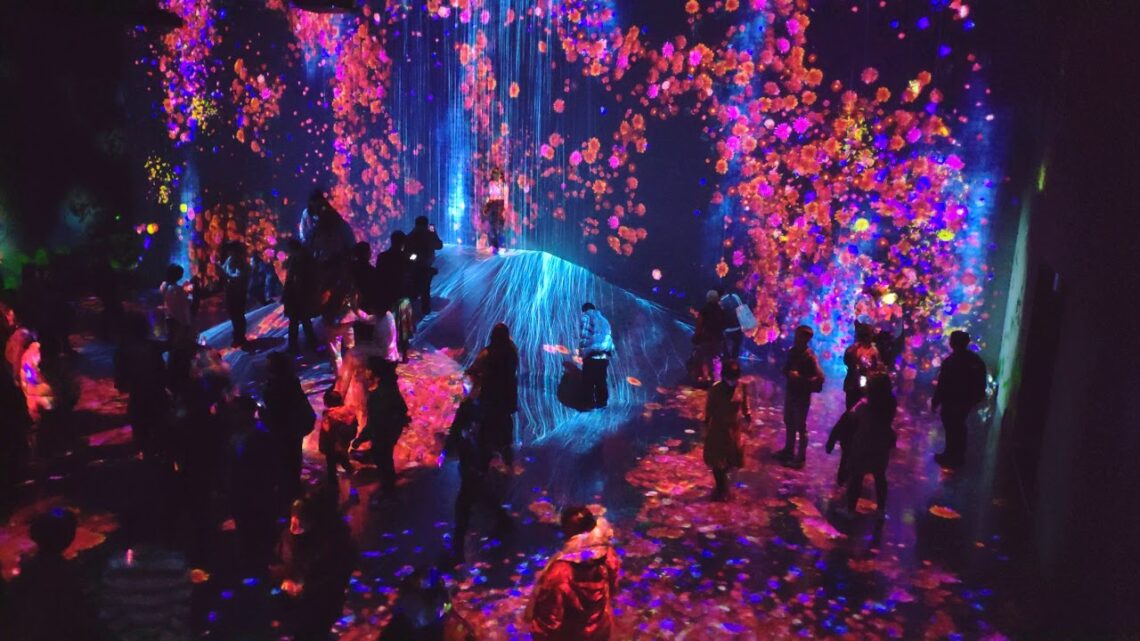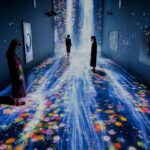Initial Problem Awareness
When planning The One Behind the Door, I quickly encountered a fundamental contradiction:
Cinema is inherently temporal and sequential; exhibition spaces are fluid and open-ended.
This contradiction raised several critical curatorial questions:
-
Should visitors enter at specific times to follow the narrative, or can they join freely?
-
If multiple visitors are present simultaneously, how should the interactive system prioritize responses? Who is the projection “serving” at any moment?
-
Should the space be organized as free-flowing or individual/small-group immersive sessions? Could a hybrid model work?
-
How can I control the technical and production budget while ensuring a high-quality immersive experience?
-
Which gestures should be recognized? How should interaction trigger narrative fragments and short film generation?
These tensions between conceptual aspirations and operational realities shaped the entire curatorial development process.
Final Space and Experience Model
After multiple rounds of adjustment, I chose a hybrid model, separating the exhibition into different zones, each operating with distinct modes but complementing each other.
| Area | Mode | Function |
|---|---|---|
| A Zone | Individual/small-group immersive experience (reservation required) | Main experience zone with high-precision interactions and narrative immersion |
| B Zone | Free exploration interaction | Visitors move freely, triggering light responses, focusing on exploratory perception |
| C Zone | Public observation wall | (Later cancelled during development to optimize flow and reduce budget) |
| D Zone | Cold-start narrative & waiting area (merged into A Zone entrance) | Emotional preparation and narrative transition area |
📸 Insert suggestion 1: Here you can add a simple space layout sketch (showing A and B zones only after C’s cancellation).
Why a hybrid model?
-
A Zone offers depth and reserved immersive experiences.
-
B Zone lowers the barrier, enabling spontaneous, lighter engagement.
-
C Zone was originally intended to visualize the process, but later removed to maintain focus and save production costs.
-
D Zone was merged into A Zone’s entrance to create a natural narrative build-up without needing a separate waiting space.
This arrangement maintains Expanded Cinema’s emphasis on narrative flow while accommodating the unpredictability of exhibition audiences.
Budget and Technical Strategy
Given the project’s limited budget, I designed a strictly controlled and practical technical setup:
| Item | Details | Budget |
|---|---|---|
| Cameras | HD USB cameras ×2 | £120 |
| Software | Open-source MediaPipe / OpenPose + TouchDesigner | £0 |
| Workstation | High-performance PC | £2000 |
| Projectors | 3 units (A/B zone projection) | £1500 |
| Sound system | 2 sets of zone speakers | £300 |
| Materials | Sheer screens, basic lighting, stands | £800 |
| Total | Estimated within | £8000 |
📸 Insert suggestion 2: Insert a budget allocation table or a technical equipment schematic (showing camera positions and projection areas).
Additionally, to enhance freshness, the system now switches visual material sets every 5 minutes instead of every 10–15 minutes as initially planned.
Gesture-Triggered Narrative and Short Film Generation
Visitors’ physical gestures trigger specific spatial and narrative responses:
| Gesture | Spatial Feedback | Narrative Cue |
|---|---|---|
| Slow walking | Camera slowly pushes forward; echo increases | “Am I approaching something?” |
| Rapid movement | Camera shakes; door slams shut | “Am I being drawn into the event?” |
| Turning around | Mirrored scenes, reversed motion | “Is time rewinding?” |
| Raising hands | Light beam ascends, window opens | “Is someone calling me?” |
| Crouching | Ground detail focus, clue revealed | “I found a clue.” |
| Stretching arms | Camera rises, extended spatial perspective | “I’m flying in a dream.” |
| Staying still | Freeze frame, floating subtitles | “The movie freezes too.” |
✨ Short films generated based on action patterns:
-
Peeking Path (Observation → Exploration → Exposure → Closure)
-
Memory Delay Path (Clues emerge → Time fractures → Replay)
-
Failed Waiting Path (Approach → No door opens → Dissolution)
-
Mirror Replacement Path (Subject appears → Becomes distorted → Is replaced)
Each visitor receives a unique 60–90 second “one-minute movie” output, generated in real-time.
📸 Insert suggestion 3: Insert a gesture-feedback-short film flowchart (already drawn for you).
Theoretical Inspirations and References
Throughout the development of The One Behind the Door, I drew from both classical theatrical ideas and contemporary immersive staging practices.
First, Shakespeare’s “All the world’s a stage” from As You Like It provided a profound conceptual framework.
In the A Zone, the audience is no longer a passive observer; each visitor’s physical action shapes and propels the narrative, embodying their role within an unfolding world. As Shakespeare writes:
“All the world’s a stage,
And all the men and women merely players.”
(Shakespeare, 2005)
This perspective aligned perfectly with the Expanded Cinema goal of dissolving the boundaries between audience and screen.
Second, I was inspired by the National Theatre’s recent practices of immersive and sectional staging, notably in productions like Network and The Lehman Trilogy.
Rather than strict proscenium divisions, they allow audiences to move through fragmented spaces and experience narrative fluidity.
This led me to design The One Behind the Door with parallel modes: structured narrative immersion (A Zone) alongside free movement and discovery (B Zone), encouraging visitors to shift between the roles of participant and observer.
“In immersive staging, the audience is both spectator and participant; they inhabit the story’s world while observing its unfolding.”
(National Theatre, 2018)
These references helped solidify the project’s curatorial direction, ensuring that each visitor not only witnesses the story but becomes a co-creator of its evolving cinematic experience.
📚 References
-
Shakespeare, W., 2005. As You Like It. Oxford: Oxford University Press.
-
National Theatre, 2018. Innovations in Immersive Staging. London: National Theatre Publishing.







